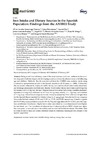Please use this identifier to cite or link to this item:
https://accedacris.ulpgc.es/handle/10553/35748
| DC Field | Value | Language |
|---|---|---|
| dc.contributor.author | Samaniego-Vaesken, Mª de Lourdes | en_US |
| dc.contributor.author | Partearroyo, Teresa | en_US |
| dc.contributor.author | Olza, Josune | en_US |
| dc.contributor.author | Aranceta Bartrina, Javier | en_US |
| dc.contributor.author | Gil, Ángel | en_US |
| dc.contributor.author | González-Gross, Marcela | en_US |
| dc.contributor.author | Ortega, Rosa M. | en_US |
| dc.contributor.author | Serra-Majem, Lluis | en_US |
| dc.contributor.author | Varela-Moreiras, Gregorio | en_US |
| dc.date.accessioned | 2018-05-08T09:53:38Z | - |
| dc.date.available | 2018-05-08T09:53:38Z | - |
| dc.date.issued | 2017 | en_US |
| dc.identifier.issn | 2072-6643 | en_US |
| dc.identifier.uri | https://accedacris.ulpgc.es/handle/10553/35748 | - |
| dc.description.abstract | Background: Iron deficiency is one of the most common nutritional problems in the world. It is frequent in both developed and developing countries and mainly affects women of childbearing age and children. Methods: Results were derived from the ANIBES cross-sectional study using a nationally-representative sample of the Spanish population (9-75 years, n = 2009). A three-day dietary record, collected by means of a tablet device, was used to obtain information about food and beverage consumption and leftovers. Results: Total median dietary iron intake was 9.8 mg/day for women and 11.3 mg/day for men. Highest intakes were observed among plausible adolescent reporters (13.3 mg/day), followed by adults (13.0 mg/day), elderly (12.7 mg/day), and children (12.2 mg/day). Prevalence of adequacy for iron intakes as assessed by EFSA criteria was higher than for the Spanish Recommended Iron Intake values in all age groups. Females had lower adequacy than males for both criteria, 27.3% and 17.0% vs. 77.2% and 57.0% respectively. Cereals or grains (26.7%-27.4%), meats and derivatives (19.8%-22.7%), and vegetables (10.3%-12.4%) were the major iron contributors. Conclusion: Higher iron intakes were observed in adolescents and were highest for non-heme iron. The prevalence of adequate iron intake according to EFSA criteria was higher than compared to national recommendations, and women had the lowest intakes. Therefore, there is a need to define standard dietary reference intake to determine inadequate iron intakes in the Spanish population. | en_US |
| dc.language | eng | en_US |
| dc.relation.ispartof | Nutrients | en_US |
| dc.source | Nutrients [ISSN 2072-6643], v. 9 (3), article number 203 | en_US |
| dc.subject | 3206 Ciencias de la nutrición | en_US |
| dc.subject.other | Micronutrients | en_US |
| dc.subject.other | Iron | en_US |
| dc.subject.other | ANIBES Study | en_US |
| dc.subject.other | Dietary survey | en_US |
| dc.subject.other | Food sources | en_US |
| dc.title | Iron intake and dietary sources in the Spanish population: findings from the ANIBES study | en_US |
| dc.type | info:eu-repo/semantics/Article | en_US |
| dc.type | Article | en_US |
| dc.identifier.doi | 10.3390/nu9030203 | en_US |
| dc.identifier.scopus | 85014367200 | - |
| dc.identifier.isi | 000397023600022 | - |
| dc.contributor.authorscopusid | 57200185770 | - |
| dc.contributor.authorscopusid | 36104396800 | - |
| dc.contributor.authorscopusid | 24468551700 | - |
| dc.contributor.authorscopusid | 57189854963 | - |
| dc.contributor.authorscopusid | 56244656400 | - |
| dc.contributor.authorscopusid | 6701646524 | - |
| dc.contributor.authorscopusid | 6603168783 | - |
| dc.contributor.authorscopusid | 35596972100 | - |
| dc.contributor.authorscopusid | 55917735600 | - |
| dc.identifier.issue | 3 | - |
| dc.relation.volume | 9 | en_US |
| dc.investigacion | Ciencias de la Salud | en_US |
| dc.type2 | Artículo | en_US |
| dc.contributor.daisngid | 3766361 | - |
| dc.contributor.daisngid | 1877048 | - |
| dc.contributor.daisngid | 676580 | - |
| dc.contributor.daisngid | 600422 | - |
| dc.contributor.daisngid | 22128 | - |
| dc.contributor.daisngid | 66582 | - |
| dc.contributor.daisngid | 77498 | - |
| dc.contributor.daisngid | 28836 | - |
| dc.contributor.daisngid | 336641 | - |
| dc.utils.revision | Sí | en_US |
| dc.contributor.wosstandard | WOS:Samaniego-Vaesken, MD | - |
| dc.contributor.wosstandard | WOS:Partearroyo, T | - |
| dc.contributor.wosstandard | WOS:Olza, J | - |
| dc.contributor.wosstandard | WOS:Aranceta-Bartrina, J | - |
| dc.contributor.wosstandard | WOS:Gil, A | - |
| dc.contributor.wosstandard | WOS:Gonzalez-Gross, M | - |
| dc.contributor.wosstandard | WOS:Ortega, RM | - |
| dc.contributor.wosstandard | WOS:Serra-Majem, L | - |
| dc.contributor.wosstandard | WOS:Varela-Moreiras, G | - |
| dc.date.coverdate | Marzo 2017 | en_US |
| dc.identifier.ulpgc | Sí | en_US |
| dc.contributor.buulpgc | BU-MED | en_US |
| dc.description.sjr | 1,557 | |
| dc.description.jcr | 4,196 | |
| dc.description.sjrq | Q1 | |
| dc.description.jcrq | Q1 | |
| dc.description.scie | SCIE | |
| item.grantfulltext | open | - |
| item.fulltext | Con texto completo | - |
| crisitem.author.dept | GIR IUIBS: Nutrición | - |
| crisitem.author.dept | IU de Investigaciones Biomédicas y Sanitarias | - |
| crisitem.author.dept | GIR IUIBS: Nutrición | - |
| crisitem.author.dept | IU de Investigaciones Biomédicas y Sanitarias | - |
| crisitem.author.dept | Departamento de Ciencias Clínicas | - |
| crisitem.author.orcid | 0000-0002-9658-9061 | - |
| crisitem.author.parentorg | IU de Investigaciones Biomédicas y Sanitarias | - |
| crisitem.author.parentorg | IU de Investigaciones Biomédicas y Sanitarias | - |
| crisitem.author.fullName | Aranceta Bartrina, Javier | - |
| crisitem.author.fullName | Serra Majem, Luis | - |
| Appears in Collections: | Artículos | |
SCOPUSTM
Citations
44
checked on Jun 8, 2025
WEB OF SCIENCETM
Citations
41
checked on Jun 8, 2025
Page view(s)
135
checked on Oct 12, 2024
Download(s)
133
checked on Oct 12, 2024
Google ScholarTM
Check
Altmetric
Share
Export metadata
Items in accedaCRIS are protected by copyright, with all rights reserved, unless otherwise indicated.
